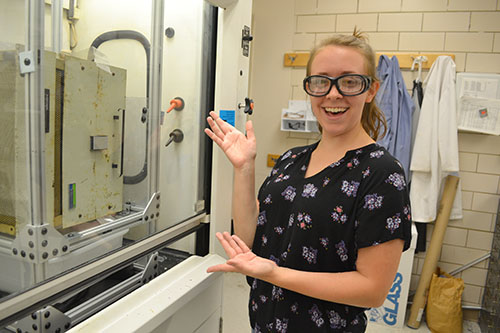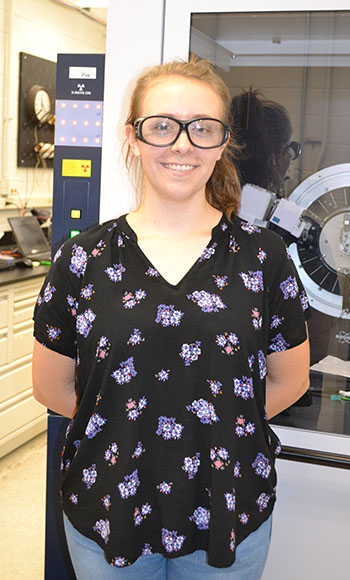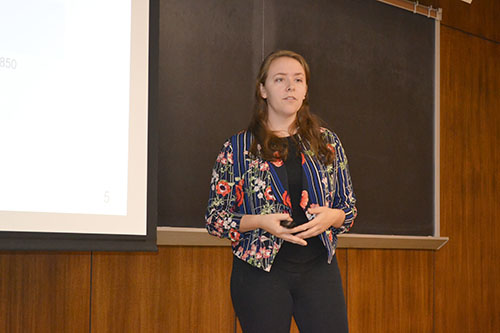I-MRSEC REU Teaches Carmen Paquette a Lot About Magnetism, Research, and Herself
August 23, 2019

Carmen Paquette.
Carmen Paquette had a lot of takeaways from her experience in the I-MRSEC (Illinois Materials Research Science and Engineering Center) Research Experience for Undergraduates (REU) this past summer. For one, the rising junior, a Material Science and Engineering major at the Illinois Institute of Technology in Chicago, learned a lot about both magnetism and material science. She also discovered what engineering research is like—lots of iterations and lots of thinking outside the box. She also grew personally, learning not to procrastinate, but to “Just do it!” And while she didn’t necessarily figure out if grad school is in her future, she did decide to just follow her heart and go full STEAM ahead when it comes to the things she’s passionate about.
Paquette shares why she chose to participate in the IMRSEC REU: “So, I was looking for experience in research because I had not had any research experience before,” she says. She had applied to quite a few REUs, and besides being the closest, the I-MRSEC REU had a lot of interesting topics specific to material science, which some of the other REUs didn’t have. “So this one had a lot,” she insists. “That was interesting, I guess, to me.”
Paquette’s research this summer in I-MRSEC researcher Daniel Shoemaker's lab was the synthesis of antiferromagnetic material. Her ultimate goal was to grow a single crystal of some material which has not yet been identified as having antiferromagnetic qualities. She indicates that there are a lot of phases of material for which the magnetism is unknown. We know it exists,” she continues, regarding the undiscovered material, “but it's just never been recorded.” In addition to synthesizing a material no one's made before, she hoped to figure out its characteristics. “You know, what's its magnetism? What does it look like under this microscope or that microscope really close up?
At the time of this interview, Paquette was really close to discovering a substance. While her mentor, Chengxi Zhao, indicates that she didn’t actually synthesize an antiferromagnetic material, she did synthesize crystals of Bi2Te3, a topological insulator material. “Her explored data of those under-studied materials have provided a very good start for our future synthesis work,” Zhao reports.

Carmen Paquette's diagram of her furnace modifications
However, what Paquette found almost as rewarding as this new material was building a special furnace in order to make it. So for the first half of the summer, she took this old horizontal furnace they gave her, tilted it on its side, redesigned it. “It's very simple concept,” she explains. “You're just going from a high heat gradient to a low heat gradient. But that's what I've been spending most of my summer on—figuring out how to get this thing to work and do what I want it to do.”
The furnace was a single heat furnace; when working normally, it had only one temperature. For example, if it was set at 500° Celsius, the temperature throughout the whole furnace would only be 500° Celsius. But Paquette needed to drop a sample so that it went through two different temperature gradients while falling from the top to the bottom: to go from a high heat to a low heat.
Because heat rises, when she turned the furnace on its side, she says science mostly did it for her: the heat had already started rising to the top. To get the heat gradient she needed, she built a frame so the furnace could sit on its side, then built a baffle shaped like a tiny donut to help separate the heat gradients.
Paquette admits that adapting the furnace was quite a task, and that she had to overcome several challenges. “I've hit quite a few roadblocks. Just today, I finally grew a sample in it—throughout yesterday—and it was finished today. And so I get to actually see if it works and characterizes.”

I-MRSEC undergrad Carmen Paquette shows off the furnace she revamped while researching the synthesis of an antiferromagnetic material this past summer in Professor Daniel Shoemaker's lab.
What were some of the challenges—some of the road blocks she encountered? For one, when testing the furnace, the thermal couple, which measures the temperature, caught on fire. Her theory was that it was improperly insulated. Standing by the furnace, she saw this blue flame inside it. “I'm like, ‘Uh oh!’ So I took it out. So it wasn't like a huge fire.” Luckily, it wasn’t a big enough fire to make the fire alarm go off and thus cause the building to be evacuated! However, she did have to put together a new thermal couple and test it again.
She also reports that she had to code the motor on top of the furnace that drops the sample. “It has to be a tuneable rate. This is very mechanical engineering. It's like coding. I had to code it.”
So all in all, Paquette had a very multi-disciplinary experience this past summer. Plus, not only did she gain a variety of experiences, but says it will all look really great on her resume: “This summer has been immersive,” she claims, regarding the things she got to do, like building a code and also being able to work with all of the instruments at MRL. “So it's been pretty, pretty awesome as far as I can put a lot of stuff down that I've done.”
Has the experience impacted her career goals at all? “I would say yes,” she admits, “in the way that I came here to figure out if research was for me, if that was something I wanted to do—go to grad school.” While her grad school decision is still up in the air, it appears that Paquette may have discovered exactly what she does want to do and, similar to her research experience, it’s quite multidisciplinary..
More of a nontraditional student, Paquette is a little older than most students at this stage in their careers. Why? Currently a professional tap dancer, she’s spent quite a few years honing her dance skills and serving as an apprentice. In fact, even this summer while in Champaign, she was working at her craft, going back to Chicago on weekends doing tap dance shows, then coming back here during the week and doing research.
“And I am very tired,” she admits. “But I didn't know what I wanted to do,” she explains, regarding her two seemingly disparate passions. But this summer has given her an epiphany. Paquette has discovered that she’s not just passionate about STEM (Science, Technology, Engineering, & Mathematics), but STEAM (which incorporates the ARTS.) Her goal is to somehow incorporate tap and science into her future. “I want to combine the science and the art aspects of what I do,” she admits, “and I think it would be really cool.”

I-MRSEC undergrad Carmen Paquette by one of the instruments she learned to use in Daniel Shoemaker's lab.
In fact, she created a dance about her summer experience, and describes the thought process she has been going through to choreograph it. “So it's taking all of the science that I've learned from the summer, ‘cause I didn't know much about magnetism. And now I know way more about magnetism. And I took the entire process, from the heat gradient being the music, and then the magnetic moments being the rhythm…and I took it all, and I've translated it into a piece.”
This reporter asked to see the dance, but while Paquette was amenable to that, she said a professional video of her dance will actually be available in September, because a video platform that highlights female artists in Chicago is going to be filming her dance. And since Paquette’s experience this summer was the catalyst, she intends to share the video with I-MRSEC.
In fact, her decision to attend the REU was quite serendipitous, because I-MRSEC is getting quite a reputation for incorporating science and the arts as part of its Scientific Communication component. For instance, they just released a video series called Magnetic Fields which they hope will teach young people about Magnetism in an entertaining way. Also, this past spring, they also did a program called Musical Magnetism with eighth graders at Franklin STEAM Academy in Champaign. The students wrote raps about different science principles which were then video recorded. The videos created during both projects will be useful to teach students about magnetism in classrooms.
Regarding her STEAM dream, Paquette says her summer experience has helped her network with people, talking with them about what's actually possible. “Because it's kinda difficult…A lot of people on the science side don't really understand artists, you know? And then the artists are like, ‘Why are you doing science?’ And so it's been really helpful in that respect and then helpful with gaining all of this experience, because I feel like it does translate better than a lot of people kind of assume that it will.”
Regarding her passion for dance, in addition to performing throughout the city, her dance company also teaches at the Afterschool Matters program. “So it's a lot of working with kids,” she explains, adding: “It's really fulfilling to be able to be a part of that, ‘cause it's something that I've worked towards for a very long time. And so to be able to do that and then also pursue the engineering and the school at the same time, it's challenging. But I would say it's rewarding.”
In terms of Paquette’s dream job, she reports that it’s fluid: “I think I used to know what it was, but it keeps changing. I don't think that's necessarily a bad thing.” She shares one life lesson she’s learned so far: “You really can't plan. I know it's kind of cheesy, but if you just kind of go with where your heart leads, you end up in really cool spots, and that's where I'm going. I know that the general idea is to combine somehow the science side of my brain, and the artistic side, and my expertise in each, and then eventually that will culminate in something in my life. But I don't have anything very particular yet; I'm keeping a very open mind.”

Carmen Paquette presents her research about synthesis of antiferromagnetic materials to visitors at the REU's August 2nd final presentation event.
Paquette had lots of other takeaways from this summer. For example, in addition to learning that engineering is one iteration after another until you finally get the thing to work, she shares another: “I like how research is very creative. It very much requires thinking, and thinking outside the box. She also says it requires just doing it. She reports that at the beginning, she would draw the design and try to figure out the best thing to do. “But then when I actually went to apply it, it did not work the way I thought it was going to,” she admits. “So I think it's about not being afraid to just take the step.” She’s vowed that from now on, she’s not going to wait until she’s got everything figured out—until she thinks it’s perfect.
“And I think that's been a big lesson for me throughout the summer: it's okay to just try things. And that's the great thing about research.” She believes that notion has helped her creative side, “My tap dance side, my choreographing. And to do this piece, I'm going to just do it. It's okay if it doesn't work; it's okay if it's not good, because that's the point, right? That's how you get better. So I think that's been great.”
Paquette also believes that the REU helped her grow as a student—a testament to how beneficial hands-on activities and projects are to learning.
“Well, everything I have done this summer has been applicable to what I'm doing in material science in school. I've actually looked at quite a few phase diagrams, which is something that I learned about briefly in a class last semester, but now I feel very confident in it. So there's a lot of, I guess you could say, book learning that now makes sense to me because I’ve actually done it in real life.”
Story and photos by Elizabeth Innes, Communications Specialist, I-STEM Education Initiative.
For additional articles about the I-MRSEC REU, see:
More: Externally Funded, I-MRSEC, MatSE, Physics, REU, Science Center, 2019













.jpg)
















